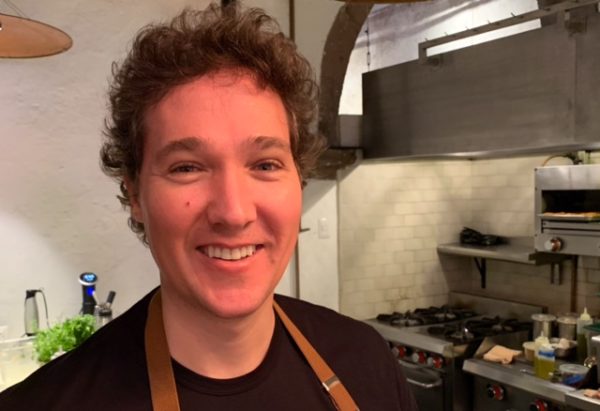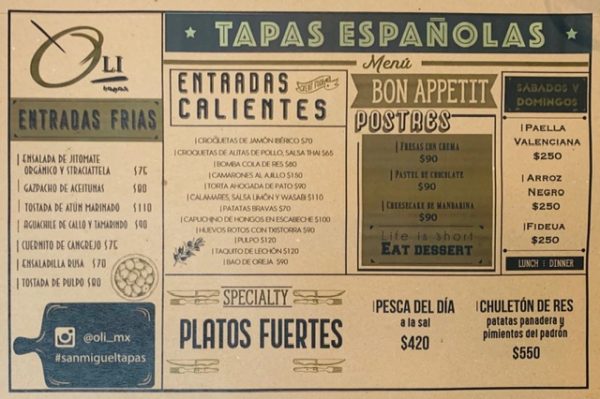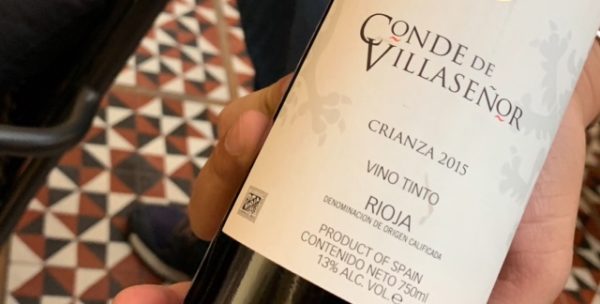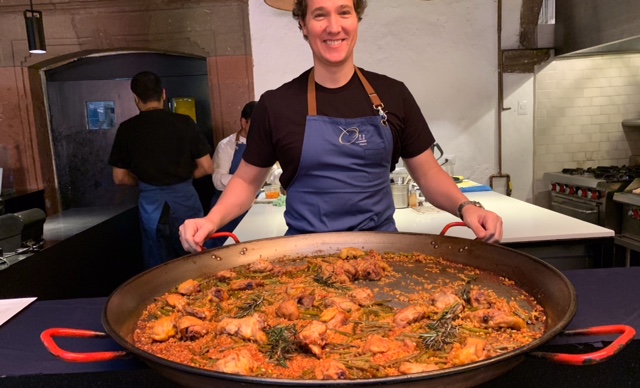I tried to guess how many times I’d had paella in my life. My estimate was somewhere around 100. Then I tried to remember how many times the restaurant had called it Paella Valenciana. That was more difficult to remember but my guess was somewhere around half of the time.
My next guess was how many times what the menu had called Paella Valenciana was actually a genuine, traditional, Valencia-style paella. My guess was maybe once, maybe twice, maybe never…at least until last Sunday.
Last Sunday I had an authentic Paella Valenciana at the recent-arrived San Miguel restaurant Oli Tapas. How do I know this paella was the real thing. Well, the executive chef of Oli is Vicente Torres and, though Chef Torres is originally from Ibiza, he rose to fame in Valencia, earning a Michelin star at restaurant La Sucursal.
Now what makes a Paella Valenciana different from other paellas or what Chef Torres calls “paellas mixtas”.

First, it must, be produced in the vessel from which the name of the dish came from, the steel pan called the paella or paellera. The pan that Vicente Torres used last Sunday was so big that getting it through the kitchen door took three people and some precarious angling of the paella.

Second, the paella must be cooked on a special oversized gas burner so that the heat from the flames is equally distributed to the underside of the paella.
Then there is what goes in the pan. Almost every Spanish chef will you that paella “is all about the rice”.
Local Mexican chef, Flavio Ramirez, the man they call the paella ninja, personally told me, “The main event is the rice. It’s always the rice.”
Rice has been cultivated in Spain since shortly after the Moors arrived in the 8th century and the natural wetlands of Valencia were ideal for growing the grain. There are four different types of Spanish rice that can go into Paella Valenciana: bomba, senia, calasparra and bahia.

“I always use senia rice”, Chef Torres told me, “It’s the rice in a typical Valencia kitchen”.
Senia is a round, short grain variety that absorbs more liquid than other rices and takes on a very creamy texture after cooking.
After the necessity of a Spanish rice for Paella Valenciana, the list of ingredients is a little more vague and it’s not so much what goes into paella, it’s what doesn’t go in. The acceptable ingredients for an authentic Paella Valenciana include chicken, rabbit, snails, dried white beans, artichokes, green beans, onion, garlic, tomatoes, chicken broth, olive oil and rosemary. Using all of these ingredients in a Paella Valenciana is not, however, necessary and there were no snails, white beans or artichokes noticeable to the eye or the tongue in Oli’s paella.
What seems to upset traditional chefs most is when a traditional paella is advertised and contains things like shrimp, mussels or chorizo that may belong in a paella mixta but not in a Paella Valenciana.

“There are many chefs cooking Paella Valenciana with other ingredients”, said Chef Torres, “and, for me, it’s terrible because they are losing the original recipe.”
There is one more thing that Vicente considers “a principal ingredient” in Paella Valenciana and that is saffron or, as he calls it, azafrán.
As you probably know, the spice that comes from the stigma and style of an autumn flowering crocus is also the world’s most expensive spice. The Spanish saffron we buy in Canada costs about 90,000 Mexican pesos a kilo.
Fortunately, a pinch is all that’s required in a paella for four people. But that’s still a lot for a peso pincher.
Don Day’s Wife and I aren’t even sure we can taste saffron in a paella. Sticking our nose in the jar, all we can smell is hay. And I admit to being totally fooled by paellas that used turmeric or colorings like Carmencita or El Aeroplano instead of real saffron.
“I think saffron is almost all about color and has little to do with taste”, said Don Day’s Wife and I agree. But, as you can imagine, Vicente Torres doesn’t. Saffron is “a principal ingredient” of Paella Valenciana and without it, a paella isn’t a Paella Valenciana.
So how was Oli Tapas Paella Valenciana? What was it like eating a plate of culinary history?
It was good, very good, and not quite like eating any other paella of recent memory.

I am used to the paella (in this case I’m referring to the pan) being filled about four or five inches deep with ingredients; Chef Torres paella was only about an inch or two deep. I’m used to the rice in paella being quite wet; Chef Torres paella had more of a glazed texture, I’m guessing from the amount of olive oil he uses. Chef Torres paella was more of a reddish gold rather than a yellowish gold; I’m guessing from using real saffron.

Chef Torres paella had the best and most soccarat, the treasured crispy crust at the bottom that I’ve ever seen; I’m guessing because of the shallow layer and the amount of oil he uses. Chef Torres paella had a lot more bone than flesh in the chicken and rabbit; I’m guessing it was because the meat was there mostly for the broth and I was told later that “In Valencia they often gather round the pan, pushing the meat to the center and don’t even bother with it unless they’re still hungry after eating the rice”.

One more thing I liked about Oli’s Paella Valenciana was the price. At 250 pesos, there’s still room in my budget to split a couple of their tapas before digging into paella as the main. You can read my raves for some of their tapas here:
And on the subject of price, one more large plaudit to Oli Tapas. I was very dismayed when, on my first visit, the restaurant didn’t have a glass of red under 200 pesos or a bottle under 1000 pesos. You see, I have made a little promise to myself that I will not patronize establishments with only high-priced wines because, frankly, I can’t afford high-priced wines. So I was delighted to see things have changed. Oli has lowered the price of the wines and raised the chances I’ll be back on another Sunday very soon.

Oli Tapas is in the interior of Doce 18, located at Calle de Relox 18 in San Miguel de Allende, Mexico. The restaurant is open Monday to Thursday, 1:00 to 9:00 pm; Friday and Saturday, 1:00 to 11:00 pm; and Sunday 1:00 to 7:00 pm. Paella Valenciana, Arroz Negro and Fideua are only available on Saturday and Sunday.


Glen, could you also include the phone numbers of the places you talk about please . Often a bugger to find after to reserve!
Thanks for this review. I noticed the paella on the menu during our earlier visit and we need a good paella place in SMA. I see on the menu that the paella is only available on Saturday/Sunday. Going there on a Saturday evening also solves the problem of their far-too-early weekday closing time of 9pm. I didn’t think we would return after our first visit since we were chased out half-way through our dinner (at 9pm) but we’ll give it another go for the paella.
Glen , spot on very good tapas, very nice combination of flavors, the oxtail dish could have a stronger taste and the scallops were too cold for my taste, but still deserves for me 5 ⭐️ and the best tapa place in SMA
Thanks for your recommendation